The Monitoring and Analysis of Land Subsidence in Kunming (China) Supported by Time Series InSAR
Abstract
:1. Introduction
2. Study Area and Datasets
2.1. Study Area
2.2. Datasets
3. Methodology
3.1. PS-InSAR Method
3.2. SBAS-InSAR Method
- (1)
- It obtained SAR images in the identical area arranged in chronological order , selecting one image as the master image, and registered other SAR images on the master image. SAR image generates differential interferogram, and satisfies .
- (2)
- In terms of the differential interferogram obtained according to SAR image obtained from slave image and mater image (), the pixel interference phase with azimuth direction coordinate and range direction coordinate is written as follows:
- (3)
- For generating the subsidence sequence that achieves physical significance, the product of the average phase velocity and time of two acquisition times expresses the phase in Equation (9):
3.3. Data Processing
3.3.1. SBAS Interference Processing
- (1)
- Data preprocessing: reading 69 original images and clipping the study area using vector files.
- (2)
- Connection diagram and connection pair image generation: the super master image was the image dated 5 November 2018. The max normal baseline was set to 2%, and the max temporal baseline threshold was set to 60 days. Lastly, 316 image pairs were generated, as depicted in Figure 2a.
- (3)
- Interferometric workflow: 316 image pairs were conducted interferometric procession. Coregistration, interferogram generation, interferogram flattening, filtering and phase unwrapping were carried out. Coregistration all image pairs was conducted with the super master image to prepare for orbit refinement, re-flattening and SBAS inversion. The unwrapping method selected in this study was minimum cost flow. The advantage of this method was that better results could be obtained when the unwrapping was difficult due to large areas of low coherence or other factors limiting growth. Goldstein was selected as the filtering method.
- (4)
- Orbit refinement and re-flattening: This was adopted for estimating and removing the residual phase. Ground control points (GCPs) were employed for correcting SAR data because of inaccurate DEM geographic positioning or inaccurate satellite orbit. Criteria for GCP selection are elucidated below: (1) Selecting the area without residual terrain fringe; (2) Selecting a region without deformation, unless the deformation rate of that point is known; (3) Selecting the point without phase jump; (4) The number of selected points should be more than 20. A total of 50 GCPs were selected in this study.
- (5)
- First inversion of SBAS: this step serves as the core of inversion, estimating deformation rate and residual terrain phase, and optimizing the input interferograms through secondary unwrapping.
- (6)
- The second inversion of SBAS: The residual phase of the SBAS second unwrapping interferograms was separated into low-pass phase and high-pass phase. The low-pass filter and high-pass filter are employed to filter the residual phase to obtain nonlinear deformation. The linear deformation phase and non- linear deformation phase are added together to obtain accurate surface deformation information.
- (7)
- Geocoding: the results of surface deformation were projected onto the geographic coordinate system. In this study, the results were projected onto the vertical direction. A total of 2,535,786 stable points, namely SDFP points, were obtained in this experiment.
3.3.2. PS Interference Processing
- (1)
- Data preprocessing: Data preprocessing was the same as SBAS processing.
- (2)
- Connection diagram generation: Likewise, the super master image was the image on 5 November 2018, and the connection diagram was depicted in Figure 2b. The max temporal baseline was 60 days and the min temporal baseline was 12 days.
- (3)
- Interferometric workflow: 69 SAR images were processing by coregistration, flattening and differential interferometric. 1,295,860 effective stable PS points were seleteded out by amplitude deviation index. Most of these PS points were distributed in buildings, Bridges, etc.; Lake and green areas were almost no PS points.
- (4)
- PS first inversion: the residual topography and the displacement rate were obtained to flatten the synthetic interferogram. The main method was based on the identification of a certain number of Persistent scatterers, which should be stable (change less than 1 mm) and can be detected by SAR antenna.
- (5)
- PS second inversion: in this step, the atmospheric phase was removed for obtaining the final rate of deformation.
- (6)
- Geocoding.
4. Results and Analyses
4.1. Time-Series Land Subsidence
4.2. InSAR Accuracy Assessment
- (1)
- Internal coincidence accuracy verification analysis
- (2)
- Comparison and verification with leveling results
- (3)
- Field investigation
5. Discussion
5.1. Impact Analysis of Ground Subsidence and Urban Subway Construction
5.2. Analysis of the Land Subsidence Impact and Fault Tectonic Activity
5.3. Impact Analysis of Ground Subsidence and Groundwater Extraction
5.4. Impact Analysis of Land Subsidence and Rainfall
6. Conclusions
- (1)
- The deformation results achieved by applying PS-InSAR and SBAS-InSAR techniques were consistent. There were numerous significant subsidence areas, mainly distributed in Xishan District, Guandu District and Jinning County. In the study period, the maximal annual subsidence rates identified by the two methods were −78 mm/a and −88 mm/a, respectively. The overall subsidence trend was large in the south (along the Lake Dian) and relatively small in the north. Moreover, cross-comparison verification was adopted to verify the InSAR monitoring results reliability, and the correlation coefficient of the two methods was 0.997. Compared with the identical period leveling data, root mean square error (RMSE) reached 8.5 mm/a and 6.7 mm/a, respectively. Through the field sampling investigation, the two InSAR techniques were verified with high correlation and reliability.
- (2)
- The ground subsidence of Kunming city is correlated with subway construction, geological structure and groundwater extraction. Kunming tectonic movement is significant, especially under the control by Chenggong-Fuming fault in North West. Under the special geological structure condition, considerable urban construction altered the original foundation stress state. With the increase in the load of the foundation and the excessive exploitation underground confined water in bedrock, the underground water level decreased, which lost their support for the foundation. Compression consolidation of soil under the double action of self-weight and external load induced regional ground subsidence.
- (3)
- The surface subsidence of Kunming city showed seasonal variations with rainfall. The flood season lasts from May to October. Moreover, the rainfall could replenish the soil water content and groundwater level effectively, and the land subsidence rate decreased. From November to following year April, the drought and lack of rain increased water consumption and increased land subsidence rate.
Author Contributions
Funding
Institutional Review Board Statement
Informed Consent Statement
Data Availability Statement
Acknowledgments
Conflicts of Interest
References
- Strozzi, T.; Wegmuller, U.; Tosi, L.; Bitelli, G.; Spreckels, V. Land subsidence monitoring with differential SAR interferometry. Photogramm. Eng. Remote Sens. 2001, 67, 1261–1270. [Google Scholar]
- Xu, J.Q.; Ma, T.; Lu, Y.K.; Bai, W.M.; Zhao, S.H. Land subsidence monitoring in north Henan plain based on SBAS-InSAR technology. J. Jilin Uni. (Earth Sci.) 2019, 49, 1182–1191. [Google Scholar] [CrossRef]
- Dong, S.C.; Zhong, Y.H.; Hu, H.; Huang, L.L. Ground subsidence monitoring during 2015–2018 in Changzhou based on times series InSAR method. J. NanJing Unvi. (Natrual Sci.) 2019, 55, 370–380. [Google Scholar] [CrossRef]
- Xu, Q.; Pu, C.H.; Zhao, K.Y.; He, P.; Zhang, H.Y.; Liu, J.L. Time series InSAR monitoring and analysis of spatiotemporal evolution characteristics of land subsidence in Yan’an new district. Geom Inf Sci Wuhan Univ. 2021, 46, 957–969. [Google Scholar] [CrossRef]
- Gong, L.X.; Zhang, J.F.; Guo, Q.S. Measure groundwater pumping induced subsidence with D-InSAR. IEEE Int Symp Geosci Remote Sens. 2005, 7, 25–29. [Google Scholar] [CrossRef]
- Luo, X.G.; Wang, J.; Xu, Z.; Zhu, S.; Meng, L.S.; Liu, J.K.; Cui, Y. Dynamic analysis of urban ground subsidence in Beijing based on the permanent scattering InSAR technology. J. Appl. Remote Sens. 2018, 12, 026001. [Google Scholar] [CrossRef]
- Wu, Q.; Jia, C.T.; Chen, S.B.; Li, H.Q. SBAS-InSAR Based Deformation Detection of Urban Land, Created from Mega-Scale Mountain Excavating and Valley Filling in the Loess Plateau: The Case Study of Yan’an City. Remote Sens. 2019, 14, 1673. [Google Scholar] [CrossRef]
- Zebker, H.A.; Goldstein, R.M. Topographic mapping from interferometric synthetic aperture radar observations. J. Geophys. Res. 1986, 91, 4993–4999. [Google Scholar] [CrossRef]
- Perna, S.; Wimmer, C.; Moreira, J.; Fornaro, G. Airborne DInSAR time series at X-band. IEEE Int. Symp. Geosci. Remote Sens. 2010, 2868–2871. [Google Scholar] [CrossRef]
- Buonanno, S.; Zeni, G.; Fusco, A.; Manunta, M.; Marsella, M.; Carrara, P.; Lanari, R. A GeoNode-Based platform for an effective exploitation of advanced DInSAR measurements. Remote Sens. 2019, 11, 2133. [Google Scholar] [CrossRef]
- Carnec, C.; Fabriol, H. Monitoring and modeling land subsidence at the Cerro Prieto geothermal Field, Baja California, Mexico, using SAR interferometry. Geophys. Res. Lett. 1999, 26, 1211–1214. [Google Scholar] [CrossRef]
- Xia, Y.; Kaufmann, H.; Guo, X.F. Landslide monitoring in the Three Gorges area using D-InSAR and corner reflectors. Photogramm. Eng. Remote Sens. 2004, 70, 1167–1172. [Google Scholar] [CrossRef]
- Lubitz, C.; Motagh, M.; Wetzel, H.U.; Kaufmann, H. Remarkable urban uplift in Staufen im Breisgau, Germany: Observations from TerraSAR-X InSAR and leveling from 2008 to 2011. Remote Sens. 2013, 5, 3082. [Google Scholar] [CrossRef]
- Dong, J.; Zhang, L.; Tang, M.G.; Liao, M.S.; Xu, Q.; Gong, J.Y. Mapping landslide surface displacements with time series SAR interferometry by combining persistent and distributed scatterers: A case study of Jiaju landslide in Danba, China. Remote Sens. Environ. 2018, 205, 180–198. [Google Scholar] [CrossRef]
- Li, M.H.; Zhang, L.; Shi, X.G.; Liao, M.S.; Yang, M.S. Monitoring active motion of the Guobu landslide near the Laxiwa hydropower station in China by time-series point-like targets offset tracking. Remote Sens Environ. 2019, 221, 80–93. [Google Scholar] [CrossRef]
- Bayik, C. Deformation analysis of 2020 mw 5.7 Karliova, Turkey, earthquake using DInSAR method with different incidence angle SAR data. Arab J. Geosci. 2021, 14, 273. [Google Scholar] [CrossRef]
- Tang, X.W.; Guo, R.M.; Xu, J.Q.; Sun, H.P.; Chen, X.D.; Zhou, J.C. Probing the Fault Complexity of the 2017 Ms7.0 Jiuzhaigou earthquake based on the InSAR Data. Remote Sens. 2021, 13, 1573. [Google Scholar] [CrossRef]
- Li, Y.J.; Li, Y.S.; Hu, X.P.; Liu, H.Q. Fault geometry and mechanism of the Mw 5.7 Nakchu earthquake in Tibet inferred from InSAR observations and stress measurements. Remote Sens. 2021, 13, 5142. [Google Scholar] [CrossRef]
- Yang, C.S.; Zhang, Q.; Zhao, C.Y.; Ji, L.Y. Small baseline bubset InSAR technology used in Datong ground subsidence, fissure and fault zone monitoring. Geomat. Inf. Sci Wuhan Univ. 2014, 39, 945–950. [Google Scholar] [CrossRef]
- He, X.F.; Gao, Z.; Xiao, R.Y.; Luo, H.B.; Feng, C. Monitoring and analysis of subsidence along Lian-Yan railway using multi-temporal Sentinel-1A InSAR. Acta Geodaetica et Cartographica Sinica 2021, 50, 600–611. [Google Scholar] [CrossRef]
- Zhu, B.Y.; Yao, F.Y.; Sun, J.W.; Wang, X. Attribution analysis on land subsidence feature in Hexi area of Nanjing by InSAR and geological data. Geomat. Inf. Sci. Wuhan Univ. 2020, 45, 442–450. [Google Scholar] [CrossRef]
- Ferretti, A.; Prati, C.; Rocca, F. Nonlinear subsidence rate estimation using permanent scatterers in differential SAR interferometry. IEEE Trans Geosci Remote Sens. 2000, 5, 2202–2212. [Google Scholar] [CrossRef]
- Ferretti, A.; Prati, C.; Rocca, F. Permanent scatterers in SAR interferometry. IEEE Trans Geosci Remote Sens. 2001, 39, 8–20. [Google Scholar] [CrossRef]
- Berardino, P.; Fornaro, G.; Lanari, R.; Sansosti, E. A new algorithm for surface deformation monitoring based on small baseline differential SAR interferograms. IEEE Trans. Geosci. Remote Sens. 2002, 40, 2375–2383. [Google Scholar] [CrossRef]
- Zhou, C.F.; Gong, H.L.; Chen, B.B.; Li, J.W.; Gao, M.L.; Zhu, F.; Chen, W.F.; Liang, Y. InSAR time-series analysis of land subsidence under different land use types in the eastern Beijing plain, China. Remote Sens. 2014, 9, 380. [Google Scholar] [CrossRef]
- Hu, B.; Chen, J.Y.; Zhang, X.F. Monitoring the land subsidence area in a coastal urban area with InSAR and GNSS. Sensors 2019, 19, 3181. [Google Scholar] [CrossRef]
- Yalvac, S. Validating InSAR-SBAS results by means of different GNSS analysis techniques in medium- and high-grade deformation areas. Environ Monit Assess. 2020, 192, 120. [Google Scholar] [CrossRef]
- Hakim, W.L.; Achmad, A.R.; Lee, C.W. Land subsidence susceptibility mapping in Jakarta using functional and meta-ensemble machine learning algorithm based on time-series InSAR data. Remote Sens. 2020, 12, 3627. [Google Scholar] [CrossRef]
- Hussain, M.A.; Chen, Z.L.; Shoaib, M.; Shah, S.U.; Khan, J.K.; Ying, Z. Sentinel-1A for monitoring land subsidence of coastal city of Pakistan using Persistent Scatterers InSAR technique. Sci. Rep. 2022, 12, 5294. [Google Scholar] [CrossRef]
- Orhan, O. Monitoring of land subsidence due to excessive groundwater extraction using small baseline subset technique in Konya, Turkey. Environ Monit Assess. 2021, 193, 174. [Google Scholar] [CrossRef]
- Solano-Rojas, D.; Wdowinski, S.; Cabral-Cano, E.; Osmanoğlu, B. Detecting differential ground displacements of civil structures in fast-subsiding metropolises with interferometric SAR and band-pass filtering. Sci. Rep. 2020, 10, 15460. [Google Scholar] [CrossRef]
- Orhan, O.; Oliver-Cabrera, T.; Wdowinski, S.; Yalvac, S.; Yakar, M. Land subsidence and its relations with sinkhole activity in Karapınar region, Turkey: A multi-sensor InSAR time series study. Sensors 2021, 21, 774. [Google Scholar] [CrossRef]
- Zhu, W.; Li, W.L.; Zhang, Q.; Yang, Y.; Zhang, Y.; Qu, W.; Wang, C.S. A decade of ground deformation in Kunming (China) revealed by multi-temporal synthetic aperture radar interferometry (InSAR) technique. Sensors 2019, 19, 4425. [Google Scholar] [CrossRef]
- Shao, J.M.; Li, J.P.; Lu, H.J. Application of PS-InSAR technology in ground subsidence monitoring of Kunming. J. Henan Univ. Urb. Constr. 2017, 26, 45–49. [Google Scholar] [CrossRef]
- Xiong, P.; Zuo, X.Q.; Li, Y.F.; You, H. Application of dual-polarized Sentinel-1 data to subsidence monitoring in Kunming. Prog. Geophys. 2020, 4, 1317–1322. [Google Scholar] [CrossRef]
- Jiang, N.Q.; Zuo, X.Q.; Wang, Z.H.; You, H.; Zhao, Y.H. Monitoring land settlement in the main urban area of Kunming based on PS-InSAR and SBAS-InSAR. J. Guizhou Univ. (Natural Sci). 2020, 37, 72–78. [Google Scholar] [CrossRef]
- Xue, C.D.; Liu, X.; Li, B.Z.; Meng, G.T.; Li, F. Mechanism analysis of land subsidence in Kunming city area. Chin. J. Geol. Hazard Control 2004, 15, 47–53. [Google Scholar] [CrossRef]
- Perissin, D.; Prati, C.; Engdahl, M.E.; Desnos, Y.L. Validating the SAR wavenumber shift principle with the ERS Envisat PS coherent combination. IEEE Trans. Geosci. Remote Sens. 2006, 44, 2343–2351. [Google Scholar] [CrossRef]
- Foroughnia, F.; Nemati, S.; Maghsoudi, Y.; Perissin, D. An iterative PS-InSAR method for the analysis of large spatio-temporal baseline data stacks for land subsidence estimation. Int. J. Appl. Obs. Geoinformation. 2019, 74, 248–258. [Google Scholar] [CrossRef]
- Colesanti, C.; Ferretti, A.; Novali, F.; Prati, C.; Rocca, F. SAR monitoring of progressive and seasonal ground deformation using the permanent scatterers technique. IEEE Trans. Geosci. Remote Sens. 2003, 41, 1685–1701. [Google Scholar] [CrossRef]
- Lanari, R.; Mora, O.; Manunta, M.; Mallorquí, J.; Berardino, P.; Sansosti, E. A small-baseline approach for investigating deformations on full-resolution differential SAR interferograms. IEEE Trans. Geosci. Remote Sens. 2004, 42, 1377–1386. [Google Scholar] [CrossRef]
- Yu, S.Y.; Yang, Y.Y.; Zhang, P.F.; Sun, J.; Luo, J.J. Monitoring Land Subsidence and Fault Activity in Hefei City Based on MT-InSAR. J. Geod. Geodyn. 2020, 41, 398–402. [Google Scholar] [CrossRef]
- Qu, C.Y.; Dan, X.J.; Zhang, G.H.; Xu, X.B.; Song, X.G.; Zhang, G.F.; Liu, Y.H. The research progress in measurement of fault activity by time series InSAR and discussion of related issues. Seismol. Geol. 2014, 36, 731–748. [Google Scholar]
- Liu, Q.; Yue, G.S.; Ding, X.B.; Yang, K.; Feng, G.C.; Xiong, Z.Q. Temporal and Spatial Characteristics Analysis of Deformation Along Foshan Subway Using Time Series InSAR. Geomat. Inf. Sci. Wuhan Univ. 2019, 7, 1099–1106. [Google Scholar]
- Ding, X.F.; Zhang, G.D. An analysis of the geologic condctions of Haigeng geothermal well in Kunming, Yunnan. Yunnan Geol. 2019, 38, 238–243. [Google Scholar]
- Zhou, D.Y.; Zuo, X.Q.; Zhao, Z.F. Constructing a large-scale urban land subsidence prediction method based on neural network algorithm from the perspective of multiple factors. Remote Sens. 2022, 14, 1803. [Google Scholar] [CrossRef]
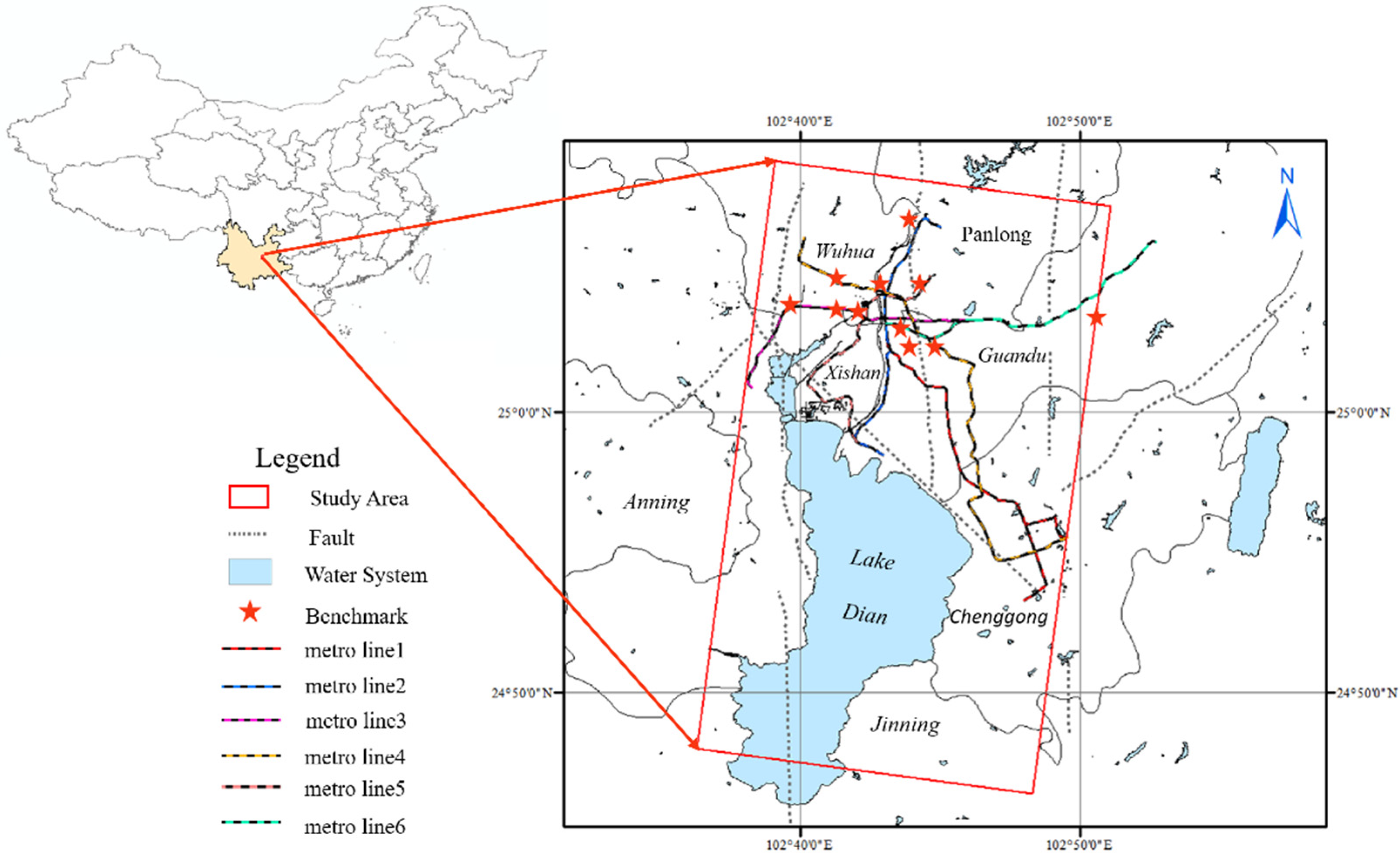
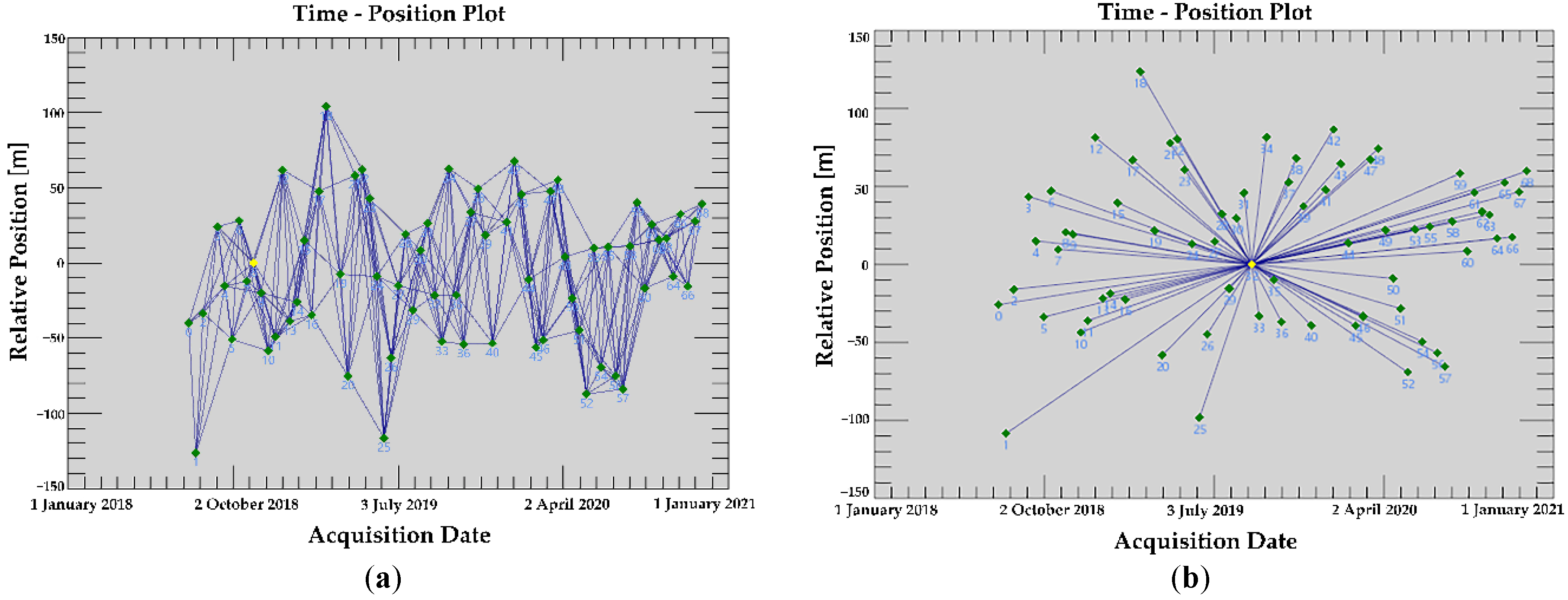
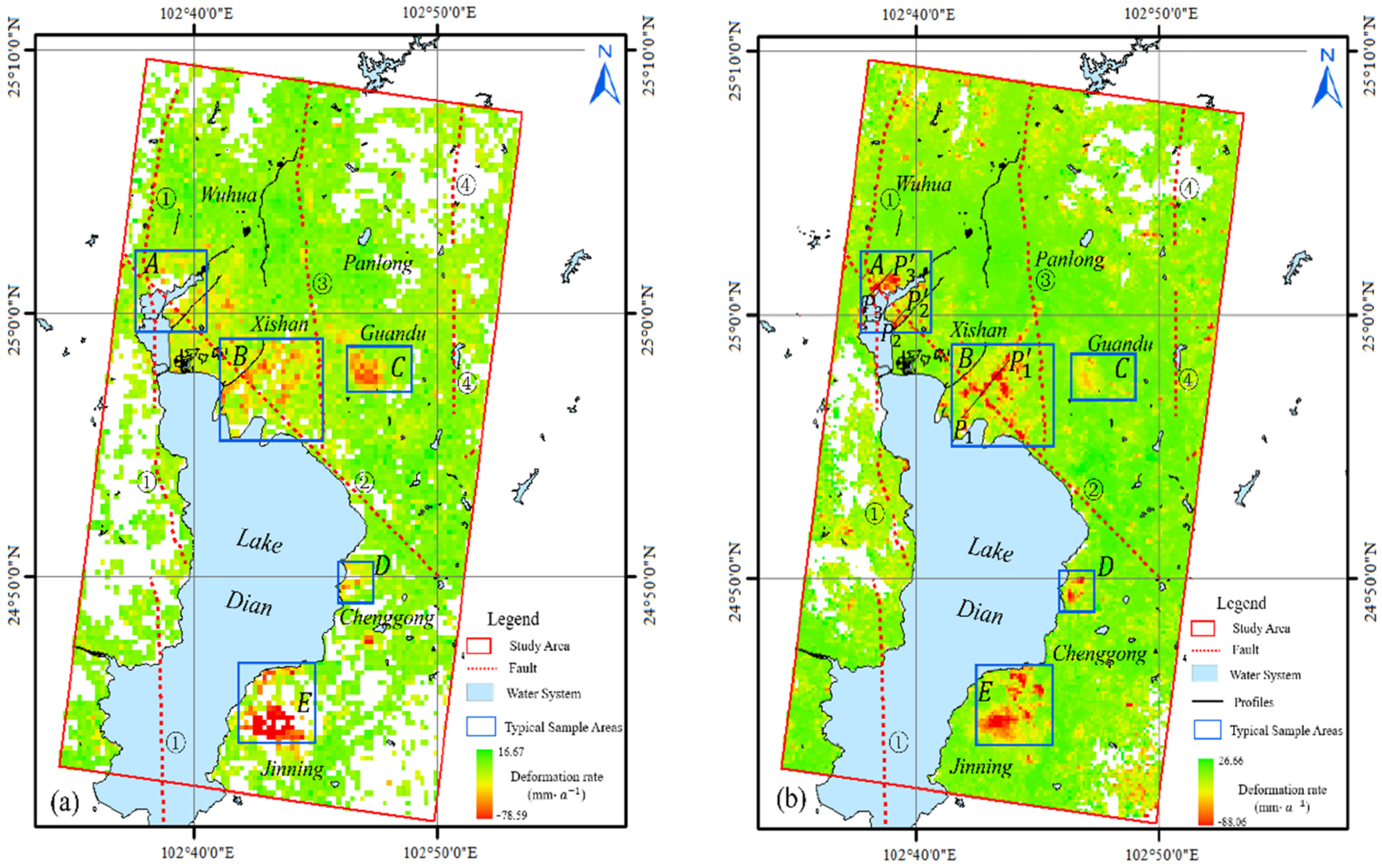
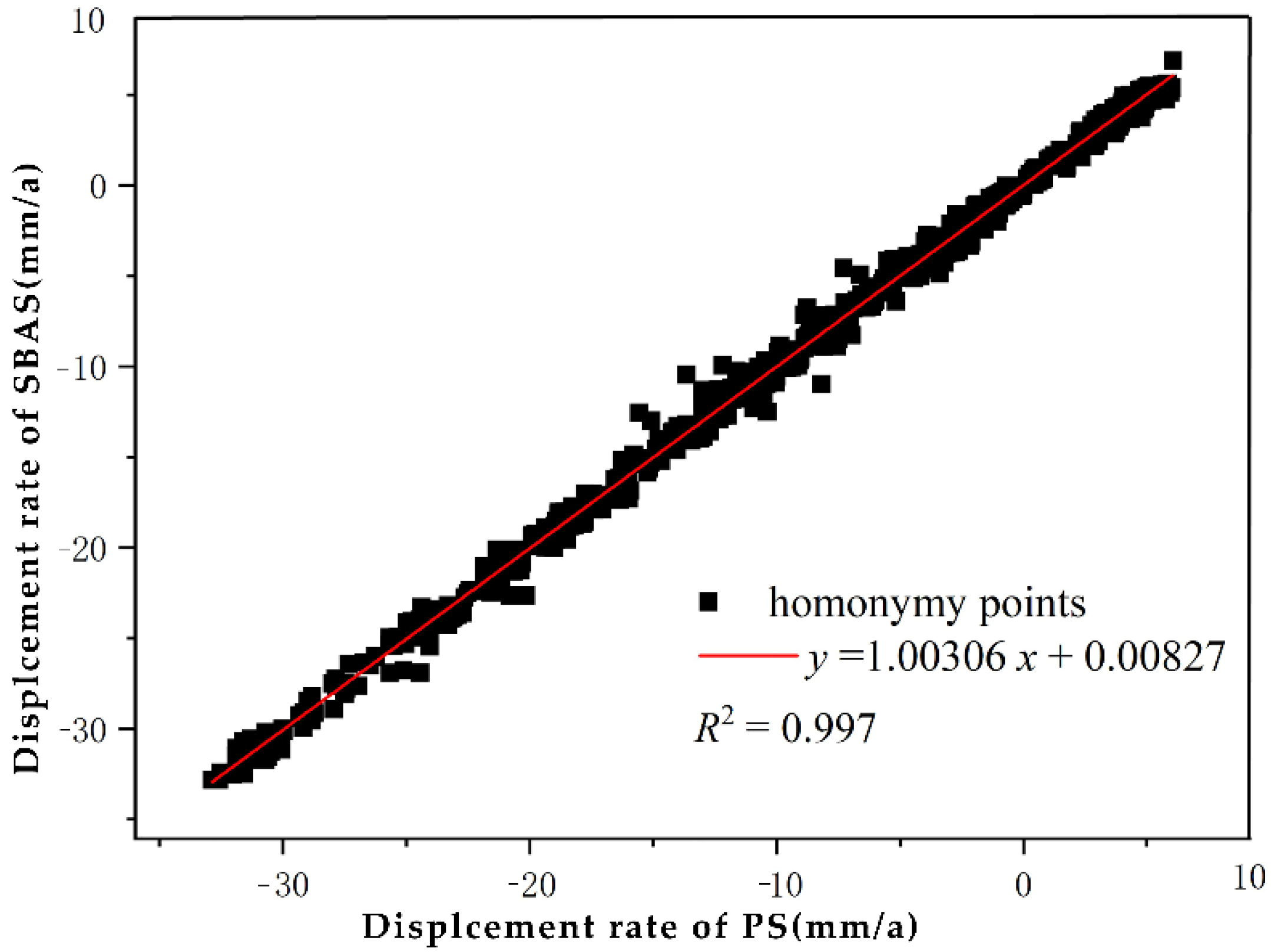

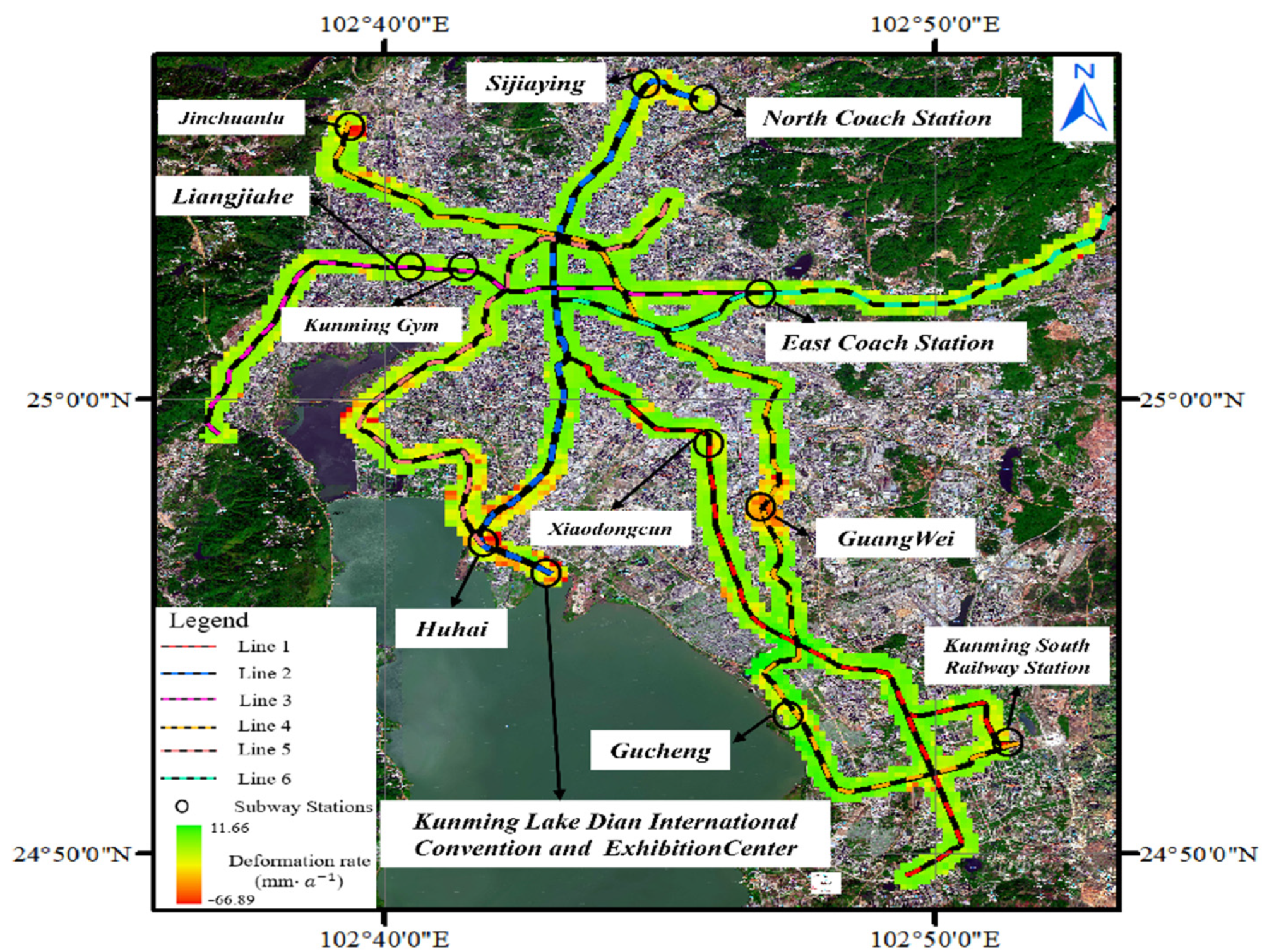
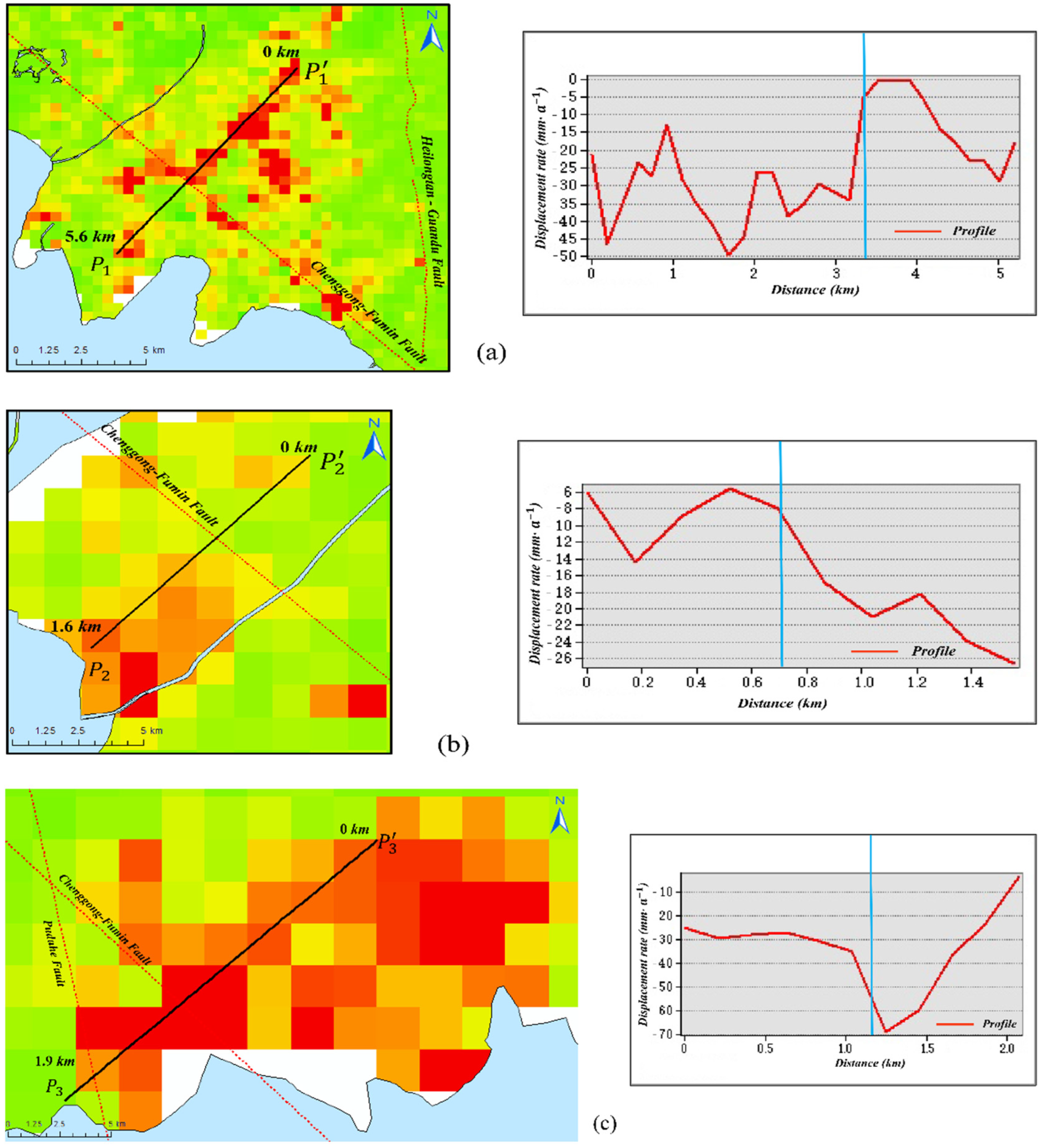
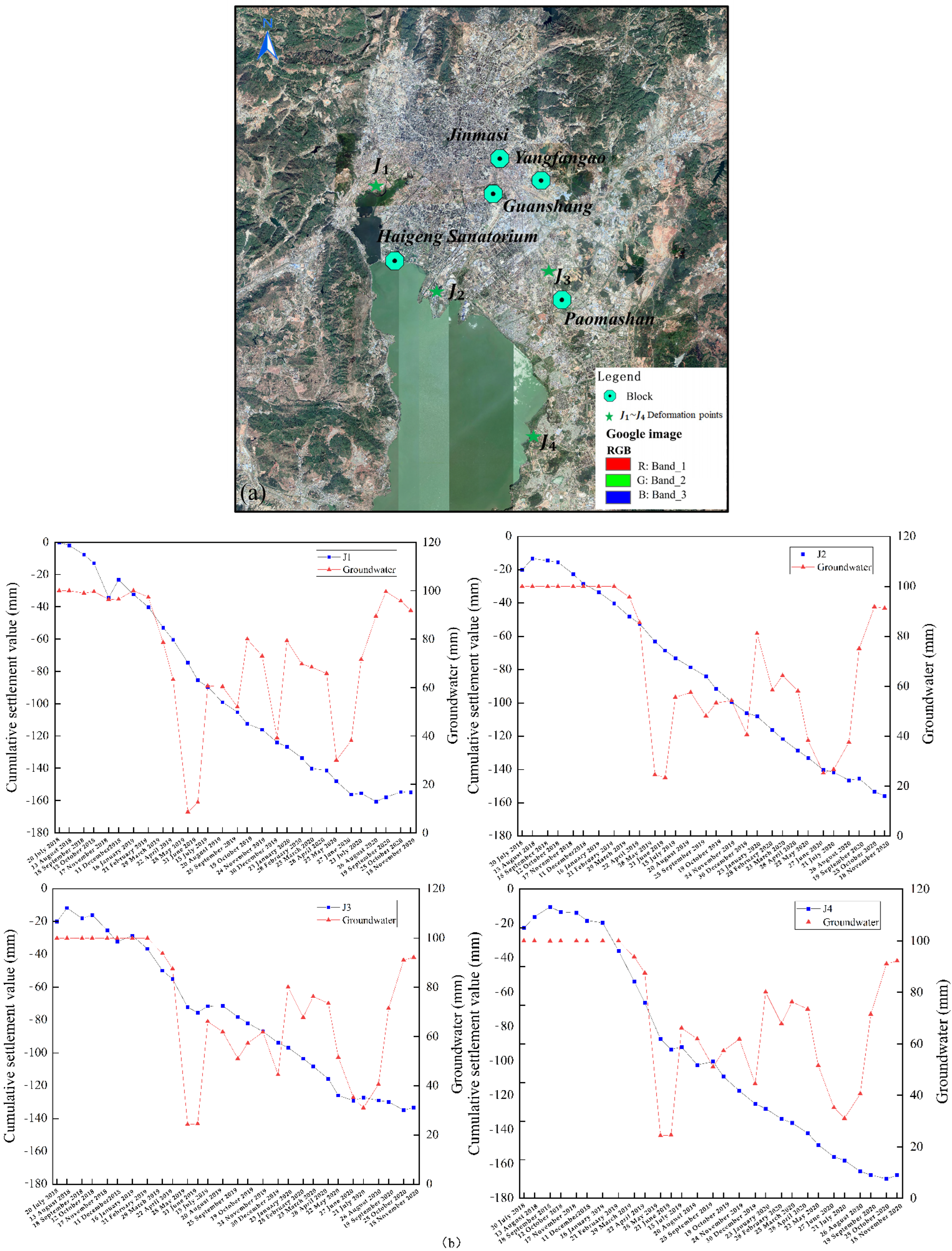
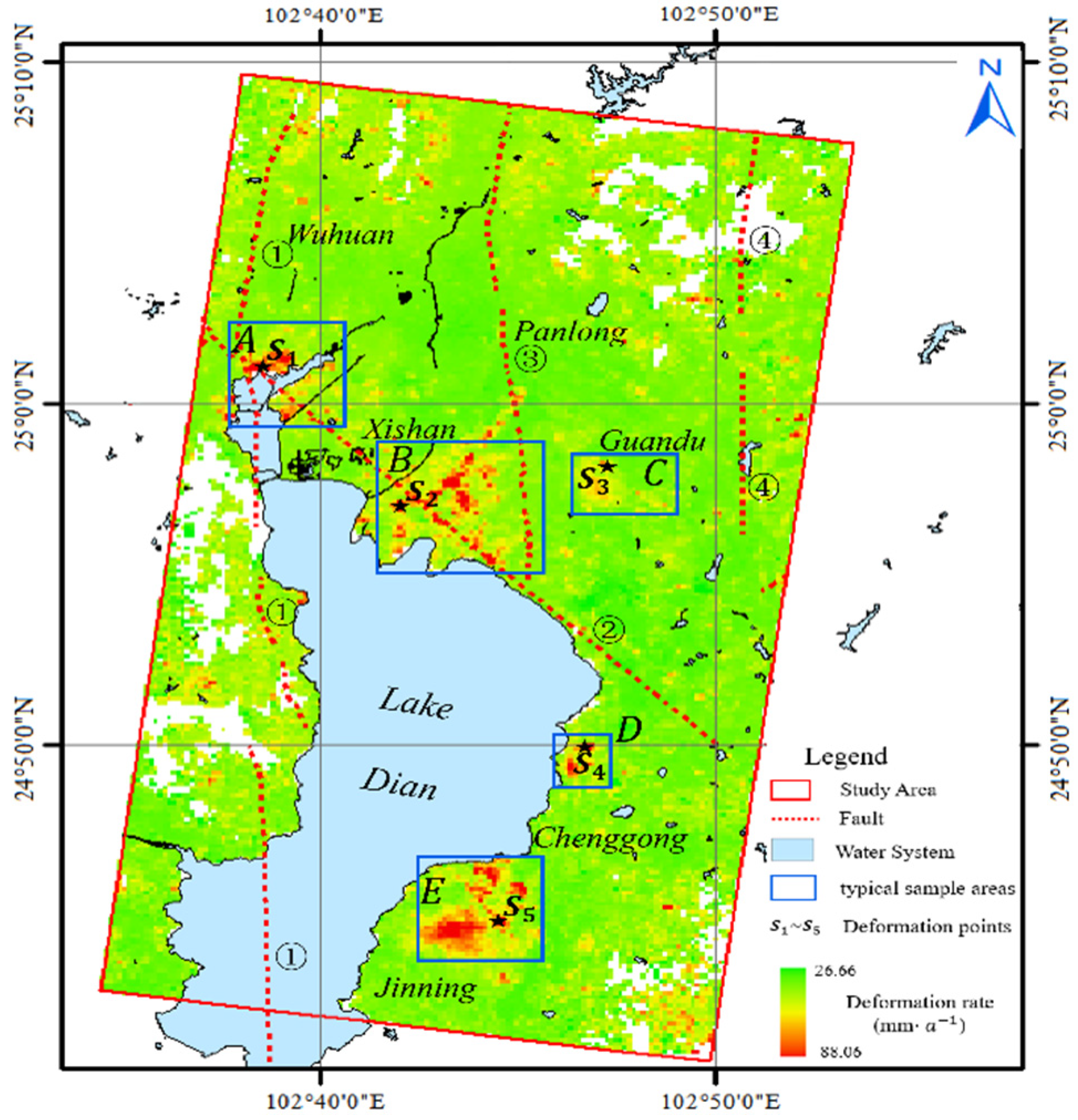
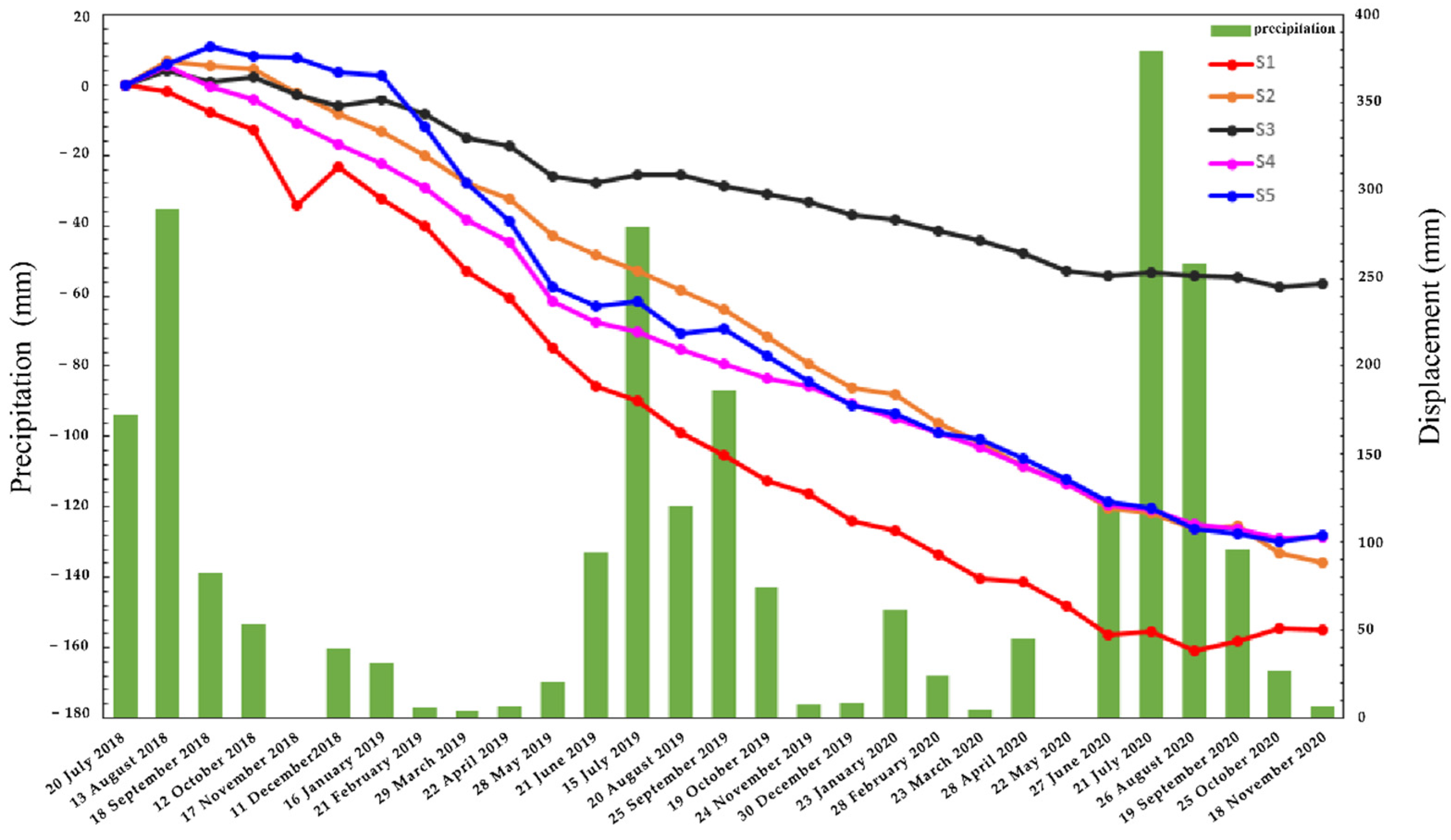
| Dataset | Orbit Mode | Incidence | Wavelength | Polarization Mode | Number | Time Span |
|---|---|---|---|---|---|---|
| Sentinel-1A | Descending | 39.5° | C | VV | 69 | 20 July 2018~18 November 2020 |
| Maximum | Minimum | Number of Stations | Deviation in (0 5) (%) | Deviation in (5 10) (%) | Deviation in (10 15) (%) | ||
|---|---|---|---|---|---|---|---|
| PS | 8.5 | 13.0 | 1.4 | 14 | 66.3 | 23.5 | 10.2 |
| SBAS | 6.7 | 11.2 | 0.9 | 14 | 71.7 | 19.2 | 9.1 |
| Subway Line | Time (20-) | Stations | Length/km | ||||||||||||||
|---|---|---|---|---|---|---|---|---|---|---|---|---|---|---|---|---|---|
| 08 | 09 | 10 | 11 | 12 | 13 | 14 | 15 | 16 | 17 | 18 | 19 | 20 | 21 | 22 | |||
| Line 1 Phase I | 18 | 41.4 | |||||||||||||||
| Line 1 Branch | 5 | 5.3 | |||||||||||||||
| Northwest Extension of Line 1 | 8 | 7.6 | |||||||||||||||
| Line 2 Phase I | 14 | 22.8 | |||||||||||||||
| Line 2 Phase II | 10 | 12.7 | |||||||||||||||
| Line 3 | 20 | 23.4 | |||||||||||||||
| Line 4 | 29 | 43.4 | |||||||||||||||
| Line 5 | 22 | 25.9 | |||||||||||||||
| Line 6 Phase I | 4 | 26.6 | |||||||||||||||
| Line 6 Phase II | 5 | 7.3 | |||||||||||||||
| Block | Number of Mining Wells (Eyes) | Minimum Spacing between Production WellS (m) | Cumulative Drawdown of Water Level (m) | Average Drop in Water Level (m/a) |
|---|---|---|---|---|
| Urban area | 28 | 150 | 20.22~25.10 | 2.26 |
| Guanshang-Jinmasi | 34 | 100 | 9.18~24.88 | 1.32 |
| Yangfangao-Paomashan | 21 | 200 | 5.70~9.38 | 1.18 |
| Haigeng Sanatorium | 46 | 150 | 11.50~21.30 | 1.62 |
| Date | Displacement (mm) | Precipitation (mm) | ||||
|---|---|---|---|---|---|---|
| 20 July 2018 | 0 | 0 | 0 | 0 | 0 | 172.8 |
| 13 August 2018 | −2 | 8 | 4 | 5 | 6 | 289.6 |
| 18 September 2018 | −8 | 6 | 1 | −1 | 11 | 82.8 |
| 12 October 2018 | −13 | 4 | 2 | −4 | 8 | 53.3 |
| 17 November 2018 | −34 | −3 | −3 | −11 | 8 | 0.0 |
| 11 December2018 | −23 | −8 | −6 | −17 | 4 | 39.3 |
| 16 January 2019 | −32 | −13 | −4 | −22 | 3 | 31.7 |
| 21 February 2019 | −40 | −20 | −8 | −29 | −12 | 5.7 |
| 29 March 2019 | −53 | −28 | −15 | −38 | −28 | 4.5 |
| 22 April 2019 | −60 | −32 | −18 | −45 | −39 | 7.1 |
| 28 May 2019 | −75 | −43 | −26 | −61 | −58 | 20.1 |
| 21 June 2019 | −86 | −48 | −28 | −68 | −63 | 94.1 |
| 15 July 2019 | −90 | −53 | −26 | −70 | −62 | 279.5 |
| 20 August 2019 | −99 | −59 | −26 | −75 | −71 | 120.7 |
| 25 September 2019 | −105 | −64 | −29 | −79 | −69 | 186.1 |
| 19 October 2019 | −113 | −72 | −31 | −84 | −77 | 74.2 |
| 24 November 2019 | −116 | −79 | −34 | −86 | −84 | 7.5 |
| 30 December 2019 | −124 | −86 | −37 | −91 | −91 | 9.0 |
| 23 January 2020 | −127 | −88 | −38 | −95 | −94 | 61.5 |
| 28 February 2020 | −134 | −96 | −42 | −99 | −99 | 24.2 |
| 23 March 2020 | −140 | −102 | −44 | −103 | −101 | 5.3 |
| 28 April 2020 | −141 | −109 | −48 | −109 | −106 | 45.3 |
| 22 May 2020 | −148 | −113 | −53 | −113 | −112 | * |
| 27 June 2020 | −156 | −120 | −54 | −119 | −118 | 122.0 |
| 21 July 2020 | −156 | −122 | −54 | −121 | −120 | 379.8 |
| 26 August 2020 | −161 | −126 | −54 | −125 | −126 | 258.0 |
| 19 September 2020 | −158 | −125 | −55 | −126 | −128 | 96.2 |
| 25 October 2020 | −155 | −133 | −57 | −129 | −130 | 26.9 |
| 18 November 2020 | −155 | −134 | −57 | −128 | −128 | 6.6 |
Publisher’s Note: MDPI stays neutral with regard to jurisdictional claims in published maps and institutional affiliations. |
© 2022 by the authors. Licensee MDPI, Basel, Switzerland. This article is an open access article distributed under the terms and conditions of the Creative Commons Attribution (CC BY) license (https://creativecommons.org/licenses/by/4.0/).
Share and Cite
Xiao, B.; Zhao, J.; Li, D.; Zhao, Z.; Xi, W.; Zhou, D. The Monitoring and Analysis of Land Subsidence in Kunming (China) Supported by Time Series InSAR. Sustainability 2022, 14, 12387. https://doi.org/10.3390/su141912387
Xiao B, Zhao J, Li D, Zhao Z, Xi W, Zhou D. The Monitoring and Analysis of Land Subsidence in Kunming (China) Supported by Time Series InSAR. Sustainability. 2022; 14(19):12387. https://doi.org/10.3390/su141912387
Chicago/Turabian StyleXiao, Bo, Junsan Zhao, Dongsheng Li, Zhenfeng Zhao, Wenfei Xi, and Dingyi Zhou. 2022. "The Monitoring and Analysis of Land Subsidence in Kunming (China) Supported by Time Series InSAR" Sustainability 14, no. 19: 12387. https://doi.org/10.3390/su141912387
APA StyleXiao, B., Zhao, J., Li, D., Zhao, Z., Xi, W., & Zhou, D. (2022). The Monitoring and Analysis of Land Subsidence in Kunming (China) Supported by Time Series InSAR. Sustainability, 14(19), 12387. https://doi.org/10.3390/su141912387





